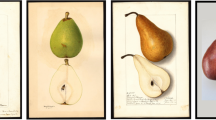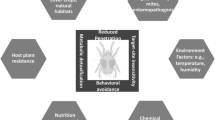Abstract
Apple scab, caused by Venturia inaequalis, is one of the most important apple diseases worldwide. To investigate between- and within-orchard fungal variability, 212 isolates were sampled from two mixed orchards, one of 10 years of age and the other of 45 years of age, in the UK and genotyped with AFLP and SSR markers. Populations of isolates from the two orchards did not differ significantly in terms of allele frequencies at the screened AFLP and SSR loci. However, groups of isolates from individual cultivars differed significantly within each orchard and there were also significant differences between groups of isolates from individual trees of the same cultivar in the same orchard. These differences were less pronounced in the younger mixed orchard than in the older one. The existence of tree-to-tree fungal variability indicates a possible role for conidia as a source of primary inoculum. Non-random mating may be one of the factors causing the significant differences among fungal populations from different cultivars. These results suggest that apparently ‘susceptible’ cultivars have different background genetic resistance factors, which can be exploited for disease management in mixtures.
Similar content being viewed by others
References
Agapow, P.-M., & Burt, A. (2001). Indices of multilocus linkage disequilibrium. Molecular Ecology Notes, 1, 101–102.
Barbara, D. J., Roberts, A., & Xu, X.-M. (2008). Virulence characteristics of apple scab (Venturia inaequalis) isolates from monoculture and mixed orchards. Plant Pathology, 57, 552–561.
Becker, C. M., Burr, T. J., & Smith, C. A. (1992). Overwintering of conidia of Venturia inaequalis in apple buds in New York orchards. Plant Disease, 76, 121–126.
Blaise, P., & Gessler, C. (1994). Cultivar mixtures in apple orchards as a mean to control apple scab? Norwegian Journal of Agricultural Science (Supplement), 17, 105–112.
Brown, A. (1980). Sample sizes required to detect linkage disequilibrium between two or three loci. Theoretical Population Biology, 96, 523–536.
Bus, V. G. M., Rikkerink, E. H. A., Caffier, V., Durel, C.-E., & Plummer, K. M. (2011). Revision of the nomenclature of the differential host-pathogen interactions of Venturia inaequalis and Malus. Annual Review of Phytopathology, 49, 391–413.
Calenge, F., Faure, A., Goerre, M., Gebhardt, C., Van de Weg, W. E., Parisi, L., & Durel, C. E. (2004). Quantitative trait loci (QTL) analysis reveals both broad-spectrum and isolate-specific QTL for scab resistance in an apple progeny challenged with eight isolates of Venturia inaequalis. Phytopathology, 94, 370–379.
Didelot, F., Brun, L., & Parisi, L. (2007). Effects of cultivar mixtures on scab control in apple orchards. Plant Pathology, 56, 1014–1022.
Durel, C. E., Parisi, L., Laurens, F., Van de Weg, W. E., Liebhard, R., & Jourjon, M. F. (2003). Genetic dissection of partial resistance to race 6 of Venturia inaequalis in apple. Genome, 46, 224–234.
Excoffier, L., & Schneider, S. (2005). Arlequin ver. 3.0: an integrated software package for population genetics data analysis. Evolutionary Bioinformatics Online, 1, 47–50.
Gao, L.-Q., Berrie, A., Yang, J.-R., & Xu, X.-M. (2009). Within- and between-orchard variability in the sensitivity of Venturia inaequalis to myclobutanil, a DMI fungicide, in the UK. Pest Management Sciences, 65, 1241–1249.
Gladieux, P., Zhang, X.-G., Afoufa-Bastien, D., Valdebenito Sanhueza, R.-M., Sbaghi, M., & Le Cam, B. (2008). On the origin and spread of the scab disease of apple: out of central Asia. PLoS One, 3, e1455.
Guérin, F., Franck, P., Loiseau, A., Devaux, M., & Le Cam, B. (2004). Isolation of 21 new polymorphic microsatellite loci in the phytopathogenic fungus Venturia inaequalis. Molecular Ecology Notes, 4, 268–270.
Hernàndez Castillo, F. D., Parisi, L., & Lespinasse, Y. (1994). Heredabilidad del factor de avirulencia de una cepa de Venturia inaequalis (Cke.) Wint. Sobre el cultivar de manzano (Malus × domestica Borkh.) Golden Delicious. Revista Mexicano de Fitopatologia, 12, 31–34.
Holb, I. J., Heijne, B., & Jeger, M. J. (2004). Overwintering of conidia of Venturia inaequalis and the contribution to early epidemics of apple scab. Plant Disease, 88, 751–757.
Holb, I. J., Heijne, B., & Jeger, M. J. (2005). The widespread occurrence of overwintered conidial inoculum of Venturia inaequalis on shoots and buds in organic and integrated apple orchards across the Netherlands. European Journal of Plant Pathology, 111, 157–168.
Kellerhals, M., Mouron, P., Graf, B., Bousset, L., & Gessler, C. (2003). Mixed planting of apple varieties: effects on diseases, pests and economics. Obst- und Weinbau, 139, 10–13.
Koch, T., Kellerhals, M., & Gessler, C. (2000). Virulence pattern of Venturia inaequalis field isolates and corresponding differential resistance in Malus x domestica. Journal of Phytopathology, 148, 357–364.
Liebhard, R., Koller, B., Patocchi, A., Kellerhals, M., Pfammatter, W., Jermini, M., & Gessler, C. (2003). Mapping quantitative field resistance against apple scab in a ‘Fiesta’ x ‘Discovery’ progeny. Phytopathology, 93, 493–501.
MacHardy, W. E. (1996). Apple scab: Biology, epidemiology, and management. St. Paul: American Phytopathological Society.
Newton, A. C. (1997). Cultivar mixtures in intensive agriculture. In I. R. Crute, E. B. Holub, & J. J. Burdon (Eds.), The gene-for-gene relationship in plant-parasite interactions (pp. 65–80). London: CAB International.
Palmiter, D. H. (1934). Variability in monoconidial cultures of Venturia inaequalis. Phytopathology, 24, 22–47.
Parisi, L., Lespinasse, Y., Guillaumes, J., & Kruger, J. (1993). A new race of Venturia inaequalis virulent to apples with resistance due to the Vf gene. Phytopathology, 83, 533–537.
Roberts, A. L., & Crute, I. R. (1994). Apple scab resistance from Malus floribunda 821 (Vf) is rendered ineffective by isolates of Venturia inaequalis from Malus floribunda. Norwegian Journal of Agricultural Science (Supplement), 17, 403–406.
Sierotzki, H., & Gessler, C. (1998). Inheritance of virulence of Venturia inaequalis toward Malus x domestica cultivars. Journal of Phytopathology, 146, 509–514.
Sierotzki, H., Eggenschwiler, M., Boillat, O., McDermott, J. M., & Gessler, C. (1994). Detection of variation in virulence towards susceptible apple cultivars in natural populations of Venturia inaequalis. Phytopathology, 84, 1005–1009.
Tenzer, I., & Gessler, C. (1997). Subdivision and genetic structure of four populations of Venturia inaequalis in Switzerland. European Journal of Plant Pathology, 103, 565–571.
Tenzer, I., & Gessler, C. (1999). Genetic diversity of Venturia inaequalis across Europe. European Journal of Plant Pathology, 105, 545–552.
Tenzer, I., degli Ivanissevich, S., Morgante, M., & Gessler, C. (1999). Identification of microsatellite markers and their application to population genetics of Venturia inaequalis. Phytopathology, 89, 748–753.
Wolfe, M. S. (1985). The current status and prospects of multiline cultivars and variety mixtures for disease resistance. Annual Review of Phytopathology, 23, 251–273.
Xu, X.-M. (2012). Super-races are not likely to dominate a fungal population within a life time of a perennial crop plantation of cultivar mixtures: a simulation study. BMC Ecology, 12, 16.
Xu, X.-M., Yang, J.-R., Thakur, V., Roberts, A. L., & Barbara, D. J. (2008). Population variation of apple scab (Venturia inaequalis) isolates from Asia and Europe. Plant Disease, 92, 247–252.
Xu, X., Roberts, T., Barbara, D., Harvey, N., Gao, L., & Sargent, D. (2009). A genetic linkage map of Venturia inaequalis, the causal agent of apple scab. BMC Research Notes, 2, 163.
Acknowledgments
This work was funded by the UK Department for Environment, Food and Rural Affairs (Defra) (Project number—HH3232STF). We thank Dr Daniel Sargent for assistance in genotyping SSR markers.
Author information
Authors and Affiliations
Corresponding author
Rights and permissions
About this article
Cite this article
Xu, X., Harvey, N., Roberts, A. et al. Population variation of apple scab (Venturia inaequalis) within mixed orchards in the UK. Eur J Plant Pathol 135, 97–104 (2013). https://doi.org/10.1007/s10658-012-0068-4
Accepted:
Published:
Issue Date:
DOI: https://doi.org/10.1007/s10658-012-0068-4




